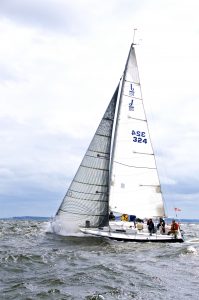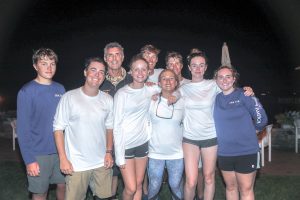Young Americans overcome adversity in the Vineyard Race
By Caitlin Owles, Alexa Shea & Elizabeth van der Voort
Young American Sailing Academy
Editor’s note: Many sailors would consider the failure of a boat’s electrical system during an overnight race sufficient cause for throwing in the towel and setting a course for the nearest tavern. For the eight teenage sailors aboard the J/105 Young American in this year’s running of Stamford Yacht Club’s Vineyard Race, quitting was never an option.
Caitlin Owles: “Hey Elliot, is it YamaYAH or YamaNAH?” This is actually a line that I yelled from the helm about 20 times on the 2018 Vineyard Race. “I’m working on it. Come on, old Betsy!” was the reply I received. We had gotten so fond of our not working J/105 engine that she was now named “Betsy” in hopes that if we were nice to our engine and gave her a name, perhaps she would start and give us back our instruments and navigation. Unfortunately, this approach was not successful. We never got our power back.
We were on hour 14 of our 26-hour upwind leg to Buzzards Tower when we went dark. Being on a boat crewed only by high schoolers and one (nominal) adult, Joe Cooper, one might expect the crew to start freaking out and thinking the worst. The exact opposite happened. Out came the magnetic compass and charts and onwards and upwards we went on the short and cute 54-hour race on Young American. If you spent 54 non-stop hours on a J/105, I’m sure you’d describe your trip as “short and cute.” Or not. I would actually describe it as “long and stressful” but also the most “exciting race I have ever done in my life.” With 32 spinnaker changes, a two-hour drift by Stratford Shoal, a confusing moment where we sailed upwind with our spinnaker up due to a wind shift, and nonstop laughter, our Vineyard Race was far from boring.
We nailed the start on the boat end and quickly made gains on the fleet, with me on the helm, Elliot Taft on main, Lizzy Van De Voort and Alexa Shea on Pit, Constantyn Van De Voort on navigation, Meg Leary on bow, and Parker Russell and Malcolm Blackwell on the rail ready to jump in whenever we needed them as the “spin guys” didn’t have much to do on a 110-mile upwind leg.
With wind speeds ranging from 2 to 26 knots, boats from 34 to 70 feet, and abilities ranging from cruising to professional, it certainly was an unforgettable race. While boats like Argo, the 70-foot trimaran that finished in around 14 hours, made me feel like I was racing against a motorcycle while I was on a bicycle, I wouldn’t have changed a thing about our race on our J/105. It provided so many sea stories that all my family is already sick of hearing, a bond between our crew, and a source of pride among the high school crew.
From now on, whenever anyone asks me about what makes Young American Sailing Academy so special, I am going to talk about the 2018 Vineyard Race. The crew showed spirit, professionalism, endurance, and courage along with many other attributes that make our sailing academy so addictive and appealing to us and other sailors. Stamford Yacht Club did an amazing job at hosting the event and let me tell you, Stamford Yacht Club has never looked so good as it came into view on our horizon at hour 53.
Alexa Shea: While racing on a 35-foot boat with enough provisioning and water, one wouldn’t expect much to go wrong in one night going to Buzzards Tower and back. But if one suddenly had no navigational lights or data on the depth, wind direction, wind speed, boat speed, bearing and more, one would probably retire.
However, that’s not what happened in our Vineyard Race. When we lost all of our power on Young American, everyone sprung to action to try and help. Because our engine sucks in air on starboard, we just assumed that we had to flood the engine. But before that happened, our coach Joe Cooper gave us spare navigation lights that he brought just in case. After flooding the engine and trying to start it in order to charge our batteries, we decided to give it a break and try again when the boat was upright.
Luckily, we had two charged phones with two different navigational apps that we used, but two phones on 20 percent wouldn’t last two days so we had to make sure we barely used them. Also, we had two compasses built into the boat and we shined a flashlight on them. After 50 hours of racing, we were near Stratford Point when the wind died and we were discussing dropping out. That idea came to an end real fast when we all realized we had come this far with no electronics and we could go another five hours because we deserved to finish.
This race definitely taught all of the juniors on Young American in multiple ways. One is the gear you pack – always have a portable charger for electronics. Also, as we learned, one person on the boat should always have emergency running lights. Another thing is always having a checklist. Make sure someone checks that the battery switch is on “both” instead of “one” so that both batteries are charged at once. There should be a checklist of ways to fix the engine if you suck air in – we tried flooding it but that didn’t work. Also on that checklist should be an extra handheld VHF radio. Even though we had a handheld, it was on very low battery coming into the finish so it’s always nice to have a spare if one dies.
The 2018 Vineyard Race truly gave me lessons on what to pack and to make sure I understand exactly how the boat I am on works. As I learned a lot from the race, so did everyone on the crew. Not only did this Vineyard Race make me understand the importance of communication amongst the crew, the importance of having backup equipment, but also making sure that everyone stays calm. If someone had freaked out during the race, we probably wouldn’t have been able to finish. I learned many life lessons from this Vineyard Race which will be in the back of my mind, and I wouldn’t have wanted to experience this with any other crew.
Elizabeth van der Voort: Ocean racing presents a lot of challenges that many adults have a hard time believing kids can handle. In this year’s Vineyard Race, Murphy’s Law had a hand in testing our abilities. As we pulled out of Milton Harbor the morning of the race, it was blowing and the beat to the start off Stamford was long, wet, and cold. Approaching the starting line we knew it was going to be a tough race as we saw our competitors lining up with reefed sails and crews in foul weather gear, but we weren’t going to let that discourage us. Our crew was made up of a rather experienced group of youth sailors with sea miles ranging from a few hundred to a few thousand, but many of us had never faced this many challenges in one race.
Going through high school, teens hear about the type of student colleges and employers are looking for, often referring to a kid with an entrepreneurial outlook; someone that is a problem solver. Although some may see offshore racing as a little vacation, it is so much more. You are constantly faced with new problems, and learning how to work with setbacks is truly a skill you can’t learn anywhere else.
Only a few hours into the race, we lost electrical power. Our first mistake was assuming that both batteries on board were fully charged, when in fact one was completely empty. Before we realized we needed to charge either battery, the second one was already dead. Although we were bummed, our astounding coach Joe Cooper was quick to use this opportunity to teach us about making assumptions. This assumption left us without instruments, radar and electronic navigation and changed the game completely, but we were not discouraged. The nice thing about a boat full of juniors is that we are all predominantly dinghy sailors so the lack of power was a little less nerve-wracking, and we were able to fashion our way using the built-in compass with known coordinates and backup charts, really challenging us to use our skills from advanced navigation class.
Another skill often billeted through sailing is leadership and teamwork. When the boat is faced with a problem, there are always people willing to put forward ideas on how to go about solving it. For instance, when we first lost power, one of our skippers, Caitlin Owles, was quick to remind everyone to save the little backup we had left on our phones for when the sun went down. When we make tactical decisions, it’s always a group discussion and never one person calling the shots.
We had our navigator, Constantyn van der Voort (my brother), pass along information regarding coordinates, course, and weather so we could make decisions as a group. We are able to make the best call because everyone’s opinion is involved, which prevents arguments later on if things don’t go quite our way. This also allows all of us to really trust one another, creating what I hope to be lifelong friends.
Despite the fact that we sat almost an entire day not moving, we finished the race, surprising everyone. My favorite part of the race was by far when we reached Stamford Yacht Club and saw the complete shock on everyone’s face – that’s really what made it worth it for me. Although many people constantly doubt our abilities, we prove time and time again we are here to race, no matter what obstacles get thrown our way. For all these reasons, I love sailing. I think we can all agree that above everything, it’s just exhilarating and it makes you ecstatic!
Caitlin, Alexa and Elizabeth and their teammates exemplify the capable, enthusiastic sailors of the Young American Sailing Academy (YASA). Leveraging off the highly acclaimed and successful Young American Junior Big Boat Team sailing out of Rye, NY, YASA is a not-for-profit program focused on developing the next generation of USA-based offshore sailors. To learn more, log onto YASailing.org.

The crew of Young American overcame electrical issues to finish fourth in their 10-boat class in the Vineyard Race. Photo courtesy of Rick Bannerot © 2018

Although they missed the awards ceremony, the exhausted but elated Young American sailors arrived at Stamford Yacht Club in time for the best regatta party on Long Island Sound. From left to right (with comments from coach and YASA board member Joe Cooper in parentheses) are Parker Russell (utility, grinder and backup nav – “He had iNav on his phone.”); Elliot Taft (main trim, backup nav, electronics and machines – “T’was he who spent hours head-down, arse-up trying to get the engine to go.”); Coop; Elizabeth van der Voort (helm, sail trim); Constantyn “Clem” van der Voort (navigator, mast, pit, sewer); Alexa Shea (helm, sail trim, pit); Malcolm Blackwell (pit, sewer, mast); Caitlin Owles (primary helm, backup nav – “She had NAVEX on her phone.”); and Margaret Leary (bow – “Killed it up there.”)
“They were all great,” Coop enthused. “Universally could sail any position, fun to be around, could focus or goof off as the circumstances dictated, could push anyone on the boat to enhance speed, and no one got wigged out. They check all the boxes.”
© Andrea Watson/SailingPress.com




